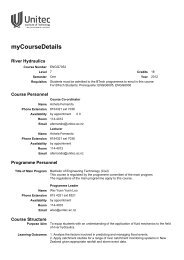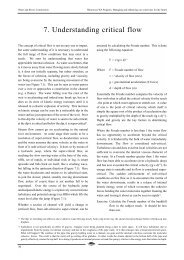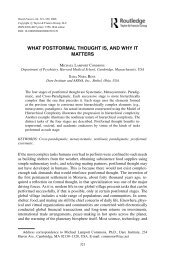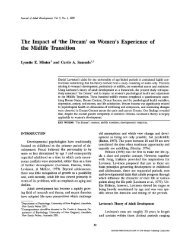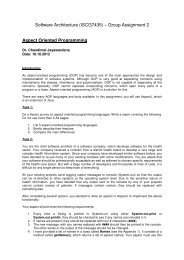Moral Development and Moral Education: An Overview
Moral Development and Moral Education: An Overview
Moral Development and Moral Education: An Overview
You also want an ePaper? Increase the reach of your titles
YUMPU automatically turns print PDFs into web optimized ePapers that Google loves.
everybody has his(her) own interest to pursue <strong>and</strong> these conflict, so that right is relative (in the<br />
concrete individualist sense).<br />
Individuals at the conventional level of reasoning, however, have a basic underst<strong>and</strong>ing of<br />
conventional morality, <strong>and</strong> reason with an underst<strong>and</strong>ing that norms <strong>and</strong> conventions are necessary<br />
to uphold society. They tend to be self-identified with these rules, <strong>and</strong> uphold them consistently,<br />
viewing morality as acting in accordance with what society defines as right. Within this level,<br />
individuals at Stage 3 are aware of shared feelings, agreements, <strong>and</strong> expectations which take<br />
primacy over individual interests. Persons at Stage 3 define what is right in terms of what is expected<br />
by people close to one's self, <strong>and</strong> in terms of the stereotypic roles that define being good - e.g., a<br />
good brother, mother, teacher. Being good means keeping mutual relationships, such as trust, loyalty,<br />
respect, <strong>and</strong> gratitude. The perspective is that of the local community or family. There is not as yet a<br />
consideration of the generalized social system. Stage 4 marks the shift from defining what is right in<br />
terms of local norms <strong>and</strong> role expectations to defining right in terms of the laws <strong>and</strong> norms<br />
established by the larger social system. This is the "member of society" perspective in which one is<br />
moral by fulfilling the actual duties defining one's social responsibilities. One must obey the law<br />
except in extreme cases in which the law comes into conflict with other prescribed social duties.<br />
Obeying the law is seen as necessary in order to maintain the system of laws which protect everyone.<br />
Finally, the post conventional level is characterized by reasoning based on principles, using a<br />
"prior to society" perspective. These individuals reason based on the principles which underlie rules<br />
<strong>and</strong> norms, but reject a uniform application of a rule or norm. While two stages have been presented<br />
within the theory, only one, Stage 5, has received substantial empirical support. Stage 6 remains as<br />
a theoretical endpoint which rationally follows from the preceding 5 stages. In essence this last level<br />
of moral judgment entails reasoning rooted in the ethical fairness principles from which moral laws<br />
would be devised. Laws are evaluated in terms of their coherence with basic principles of fairness<br />
rather than upheld simply on the basis of their place within an existing social order. Thus, there is an<br />
underst<strong>and</strong>ing that elements of morality such as regard for life <strong>and</strong> human welfare transcend<br />
particular cultures <strong>and</strong> societies <strong>and</strong> are to be upheld irrespective of other conventions or normative<br />
obligations. These stages (1 -5) have been empirically supported by findings from longitudinal <strong>and</strong><br />
cross-cultural research (Power et al., 1989).<br />
III. <strong>Moral</strong> <strong>Education</strong><br />
Kohlberg used these findings to reject traditional character education practices. These<br />
approaches are premised in the idea that virtues <strong>and</strong> vices are the basis to moral behavior, or that<br />
moral character is comprised of a "bag of virtues", such as honesty, kindness, patience, strength, etc.<br />
According to the traditional approach, teachers are to teach these virtues through example <strong>and</strong> direct<br />
communication of convictions, by giving students an opportunity to practice these virtues, <strong>and</strong> by<br />
rewarding their expression. However, critiques of the traditional approach find flaws inherent in this<br />
model. This approach provides no guiding principle for defining what virtues are worthy of espousal,<br />
<strong>and</strong> wrongly assumes a community consensus on what are considered "positive values". In fact,<br />
teachers often end up arbitrarily imposing certain values depending upon their societal, cultural, <strong>and</strong><br />
personal beliefs. In order to address this issue of ethical relativity, some have adopted the valuesclarification<br />
approach to moral education. This teaching practice is based on the assumption that<br />
there are no single, correct answers to ethical dilemmas, but that there is value in holding clear views<br />
<strong>and</strong> acting accordingly. In addition, there is a value of toleration of divergent views. It follows, then,<br />
that the teacher's role is one of discussion moderator, with the goal of teaching merely that people<br />
hold different values; the teacher does attempt to present her views as the "right" views.<br />
Kohlberg rejected the focus on values <strong>and</strong> virtues, not only due to the lack of consensus on what<br />
virtues are to be taught, but also because of the complex nature of practicing such virtues. For<br />
example, people often make different decisions yet hold the same basic moral values. Kohlberg<br />
believed a better approach to affecting moral behavior should focus on stages of moral development.<br />
These stages are critical, as they consider the way a person organizes their underst<strong>and</strong>ing of virtues,<br />
rules, <strong>and</strong> norms, <strong>and</strong> integrates these into a moral choice (Power, Higgins, & Kohlberg, 1989). In<br />
addition, he rejected the relativist view point in favor of the view that certain principles of justice <strong>and</strong><br />
fairness represent the pinnacle of moral maturity, as he found that these basic moral principles are<br />
found in different cultures <strong>and</strong> subcultures around the world (Kohlberg & Turiel, 1971).



